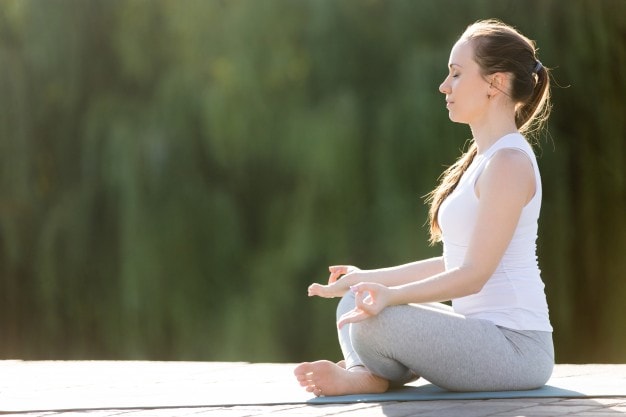Do you know any exercise technique through which your skull start shinning and face start glowing? The answer is Kapalbhati. As the name says, Kapalbhati is a Sanskrit word derived from the root word ‘Kapal’ means skull and ‘Bhati’ means illuminating or shinning. Which means Kapalbhati brings enlightment and clarity to your mind and sharpens your intellect. Due to the increased oxygen supply and clearance of blockages, Kapalbhati Pranayama produces shine on the forehead and face. Kapalbhati also produces heat; that’s why it is practiced in the beginning of pranayama, after Bhastrika. Because it is a part of SHATKARMA or body cleansing technique, it has to be done after Jal Neti so that it clears the remnants of nasal passage if any. Kapalbhati is related to the third eye or Ajna chakra, so with a regular practice of this pranayama, this chakra gets activated.

RIGHT WAY OF DOING IT
- Sit comfortably on the floor in a cross-legged posture or Padmasana (lotus pose). If not comfortable, then sit upright on the front edge of a chair with your feet flat on the floor.
- First close your eyes and breathe normally. Bring awareness to your breath for 5 minutes and then shift your awareness to lower belly and the act of breathing out.
- Inhale normally and expand your belly, then exhale forcefully 5-10 times and contract your belly during exhalation. In Kapalbhati Pranayama, inhalation is passive but exhalation is active unlike Bhastrika where both inhalation and exhalation are active.
- As you quickly exhale, your inhalation gets automatic. Do 10-15 stroke at one time initially and then increase it gradually. Take a break of one minute and then start again. Do it 5 times in the morning and 5 times in the evening.
PRECAUTIONS
- Perform Pranayama in well ventilated space; otherwise, it may lead to breathing problems and dizziness. If you are practicing in the indoors, then open doors & windows.
- Do Kapalbhati on an empty stomach and after Jel neti .
- Keep your spine and shoulders upright, so that the flow of prana is not blocked. It only moves the belly.
- Do not contract your abdomen during inhalation. It only expands it.
- Avoid doing Kapalbhati if you have high blood pressure, heart diseases, artificial pacemaker or stent, Hernia, Migraine, Epilepsy, Disc problem and abdominal surgery recently.
- Women should not practice it during menstruation and pregnancy.
- If you are pitta prakriti or the pitta is increased in your body or having pitta-related gastric problems like acidity or stomach ulcers, then do not do it.
- If you have symptoms like hyperactivity, lack of concentration, uneasiness, anxiety, nervousness, dizziness then slow down or stop doing it for a few days. It means you are overdoing it.
- Do not do it at bedtime and after meals.
BENEFITS
- Kapalbhati brings balance and clarity on mental, physical, emotional and spiritual levels because breathing consciously can clear all blockages that you did not know even existed.
- A regular practice strengthens the abdominal muscles which helps in burning belly fat as well as improving digestion and removing stomach-related problems like constipation.
- Due to stomach movements in Kapalbhati, the blood flow increases in the liver, spleen pancreas, gall bladder and intestines. Hence, it improves their functions and removes toxins.
- Kapalbhati improves blood circulation, slows down the aging process and gives facial radiance.
- This Pranayama increases oxygen supply in brain which improves memory and concentration, helps in uplifting the mind, and energizes the nervous system.
- Kapalbhati warms up the body because it produces heat in the body. Therefore, it is useful in kapha prakriti people and during the winter season. It helps in cleansing the lungs and respiratory passages.
- It increases metabolism. Hence, it improves metabolic disorders like diabetes and thyroid and aids in weight loss.
- Since it is related to the third eye or ajna chakra, it helps in activating third eye if practiced before meditation


